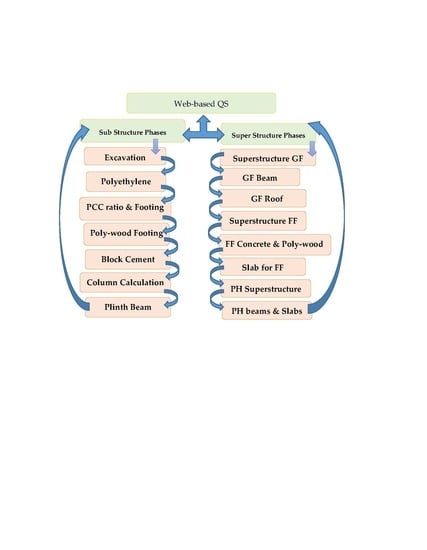Web-Based Architecture for Automating Quantity Surveying Construction Cost Calculation
Abstract
:1. Introduction
2. Literature Survey
- The absence of standard formatting for the storage and exchange of data;
- The absence of standardization in documented and reviewed pricing data;
- Different methods implemented in estimating and calculating the construction costs; and
- Insufficient information related to BIM models.
3. Research Methodology
4. Features of Quantity Surveying (QS)
4.1. QS Cost Estimation
- Construction works (repair and construction);
- Installation work;
- The cost of purchasing equipment, furniture, inventory; and
- Other costs (design, survey, research, commissioning, equipment, and systems).
4.2. BIM and QS Software
- Exporting building object quantities to an estimating software;
- Bridging the BIM tool directly with an estimating software; or
- Using BIM Quantity Take-Off (QTO).
- BIM-based Estimation faces many challenges, such as:
- Sub-standard BIM models and insufficient information;
- The data format and exchange; and
- Lack of standardization and pricing format.
5. Proposed System Design and Development
5.1. Database and Class Diagram
5.2. Software Functionalities Requirements
5.3. Results of the Proposed System Demonstration
6. Discussion
7. Conclusions
- Automating the most-needed quantity surveying duties and accurately estimating the concrete construction cost of a project in a short time (less than 3 days). It also produces the needed report and information in different formats (i.e., Excel, pdf, or word).
- Implementing a web-based framework, such that the project manager can simultaneously monitor and obtain the required estimation prices in a short time, which is also constantly updated, depending on the new conditions.
- Deploying a database management system in the proposed framework, which has many advantages such as being able to search, manipulate, and archive data easily and implement more security, such that the data cannot be altered by any unauthorized person.
- The reliability and validity of the calculations, in comparison with other methods (i.e., human work using paper or Excel).
- Offering a user-friendly interface, which ensures that the work is completed in the chronological order of the phases by directing the QSr to complete the cost calculations step-by-step.
- Reading and importing the data of the project automatically from the construction maps, in order to lessen the errors if the user were to input the data manually. It can also automatically determine the project location using Google Maps and can easily guide the user to the location.
- All computation equations were validated and approved by experts and consultant companies. In addition, the results were tested on real project data and validated with the results of paperwork, Excel work, and by experts and consultant companies. The cost estimation was carried out in accordance with the reliable standard methods of the existing pricing system.
Author Contributions
Funding
Conflicts of Interest
References
- Alrashed, I.; Kantamaneni, K. A 5D Building Information Model (BIM) for Potential Cost-Benefit Housing: A Case of Kingdom of Saudi Arabia (KSA). Infrastructures 2018, 3, 13. [Google Scholar] [CrossRef] [Green Version]
- Reizgevičius, M.; Ustinovičius, L.; Cibulskienė, D.; Kutut, V.; Nazarko, L. Promoting Sustainability through Investment in Building Information Modeling (BIM) Technologies: A Design Company Perspective. Sustainability 2018, 10, 600. [Google Scholar] [CrossRef] [Green Version]
- Adhikari, A.; Keung, C.W. The Impact of BIM on Quantity Surveyor’s Role: The Contractor Perspective. In Proceedings of the 11th International Cost Engineering Council (ICEC) World Congress and the 22nd Annual Pacific Association of Quantity Surveyors (PAQS) Conference (ICEC-PAQS Conference 2018), Sydney, Australia, 18–20 November 2018; pp. 345–361. [Google Scholar]
- Niknam, M.; Karshenas, S. A semantic web service approach to construction cost estimating. Comput. Civ. Eng. 2013, 2013, 484–491. [Google Scholar]
- Xu, S.; Liu, K.; Tang, L.C.; Li, W. A framework for integrating syntax, semantics and pragmatics for computer-aided professional practice: With application of costing in construction industry. Comput. Ind. 2016, 83, 28–45. [Google Scholar] [CrossRef]
- Aibinu, A.; Venkatesh, S. Status of BIM adoption and the BIM experience of cost consultants in Australia. J. Prof. Issues Eng. Educ. Pract. 2014, 140, 04013021. [Google Scholar] [CrossRef]
- Monteiro, A.; Martins, J.P. A survey on modeling guidelines for quantity webff-oriented BIM-based design. Autom. Constr. 2013, 35, 238–253. [Google Scholar] [CrossRef]
- Mirshokraei, M.; De Gaetani, C.I.; Migliaccio, F. A web-based BIM–AR quality management system for structural elements. Appl. Sci. 2019, 9, 3984. [Google Scholar] [CrossRef] [Green Version]
- Liu, Z.; Lu, Y.; Peh, L.C. A review and scientometric analysis of global Building Information Modeling (BIM) research in the Architecture, Engineering and Construction (AEC) industry. Buildings 2019, 9, 210. [Google Scholar] [CrossRef] [Green Version]
- Sinclair, N.; Artin, P.; Mulford, S. Construction Cost Data Workbook. In Proceedings of the Conference on the International Comparison Program, Washington, DC, USA, 11–14 March 2002; pp. 11–14. [Google Scholar]
- Martinez, M.; Scherer, R. eWork and eBusiness in Architecture, Engineering and Construction. In Proceedings of the ECPPM 2006: European Conference on Product and Process Modelling 2006 (ECPPM 2006), Valencia, Spain, 13–15 September 2006; CRC Press: Boca Raton, FL, USA, 2006. [Google Scholar]
- Ashcraft, H.W. Building information modeling: A framework for collaboration. Constr. Law 2008, 28, 5. [Google Scholar]
- Wu, S.; Greenwood, D.; Steel, G. Exploring the attributes of collaborative working in construction industry. Northumbr. Work. Pap. Ser. Interdisc. Stud. Built Virtual Environ. 2008, 1, 135–147. [Google Scholar]
- Gee, C. The Influence of Building Information Modelling on the Quantity Surveying Profession. Faculty of Engineering, Built Environment and Information Technology, Pretoria, South Africa, BSc (Hons) (Quantity Surveying), 2011. Available online: https://pdfs.semanticscholar.org/31b6/5ed8520611f1526d60ffcd0d147fde147711.pdf (accessed on 20 February 2020).
- Zima, K. Impact of information included in the BIM on preparation of Bill of Quantities. Procedia Eng. 2017, 208, 203–210. [Google Scholar] [CrossRef]
- Rabie, M.; Riad, H. Quantity Surveying Role in Construction Projects: A Comparison of Roles in Sweden and the UK. Available online: http://www.academia.edu/8906242/Quantity_surveying_role_in_Construction_Projects_-a_comparison_of_roles_in_Sweden_and_the_UK_Examensarbete_VT_2011 (accessed on 20 April 2020).
- Jiang, X. Developments in Cost Estimating and Scheduling in BIM Technology 2011. Civil Engineering Master’s Theses. Paper 20. Available online: http://hdl.handle.net/2047/d20002392 (accessed on 20 April 2020).
- Wijayakumar, M.; Jayasena, H.S. Automation of BIM Quantity Take-off to Suit QS’s Requirements. In Proceedings of the Second World Construction Symposium, Sri Lanka, Colombo, 14 June 2013; pp. 70–80. [Google Scholar]
- Marsh, D. Building Information Modelling (BIM) and the UK Quantity Surveying Organisation: A Framework for Value Creation. Ph.D. Thesis, Liverpool John Moores University, Liverpool, UK, 2017. [Google Scholar]
- Choo, S.; Park, H.; Kim, T.; Seo, J. Analysis of trends in Korean BIM research and technologies using text mining. Appl. Sci. 2019, 9, 4424. [Google Scholar] [CrossRef] [Green Version]
- Biancardo, S.A.; Capano, A.; Oliveira, S.G.; Tibaut, A. Integration of BIM and procedural modeling tools for road design. Infrastructures 2020, 5, 37. [Google Scholar] [CrossRef] [Green Version]
- Biolek, V.; Hanák, T. LCC estimation model: A construction material perspective. Buildings 2019, 9, 182. [Google Scholar] [CrossRef] [Green Version]
- Chudley, R.; Greeno, R. Building Construction Handbook, 10th ed.; Routledge Publishing Ltd.: Abingdon, UK, 2014; ISBN -13: 978–0415836388. [Google Scholar]
- Elhag, T.M.S.; Boussabaine, A.H.; Ballal, T.M.A. Critical determinants of construction tendering costs: Quantity surveyors’ standpoint. Int. J. Project Manag. 2005, 23, 538–545. [Google Scholar] [CrossRef]
- Wu, S.; Wood, G.; Ginige, K.; Jong, S.W. A technical review of BIM based cost estimating in UK quantity surveying practice, standards and tools. J. Inf. Technol. Constr. ITCon 2014, 19, 534–562. [Google Scholar]
- Ma, Z.; Liu, Z. Ontology-and freeware-based platform for rapid development of BIM applications with reasoning support. Autom. Constr. 2018, 90, 1–8. [Google Scholar] [CrossRef]

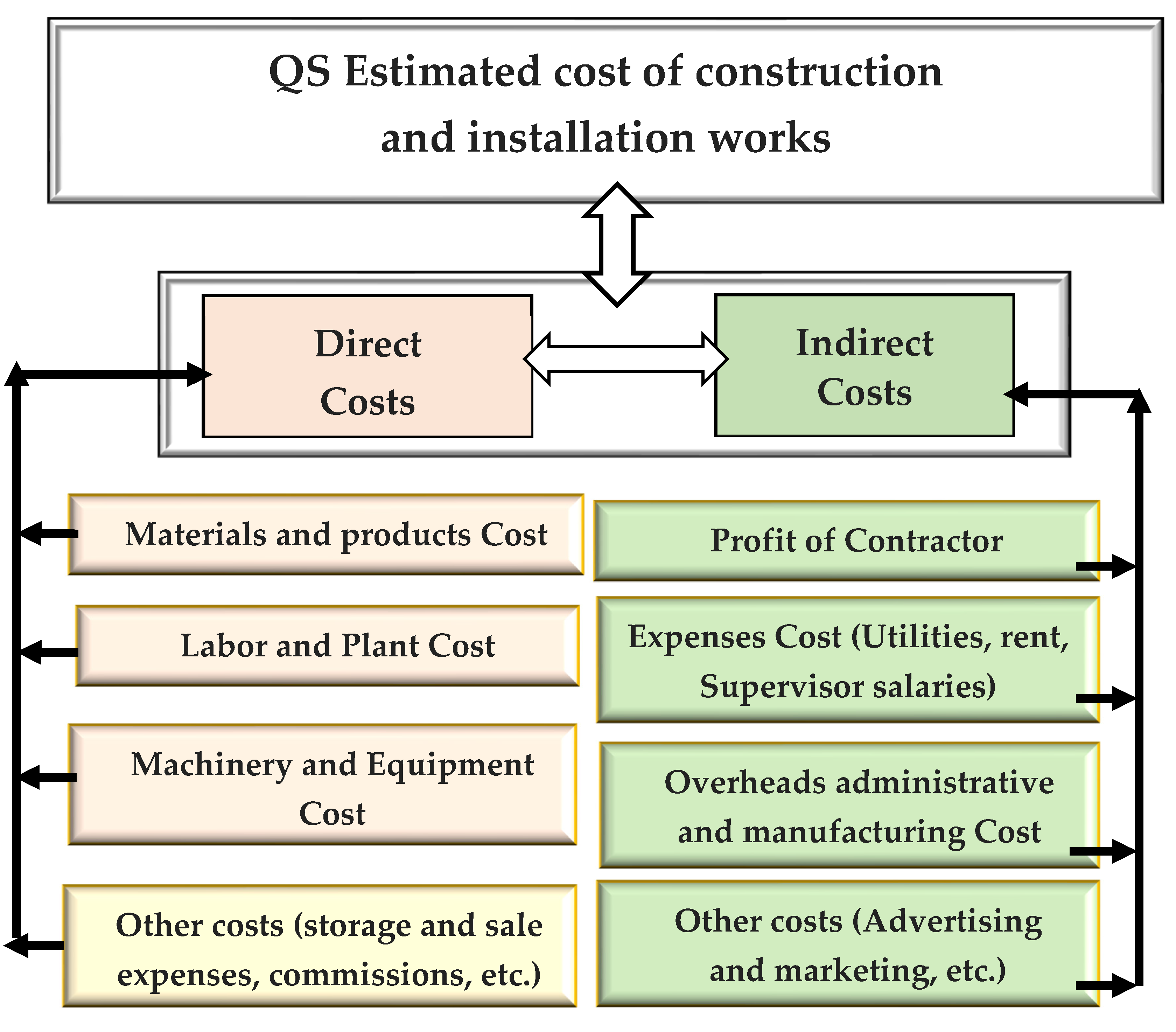
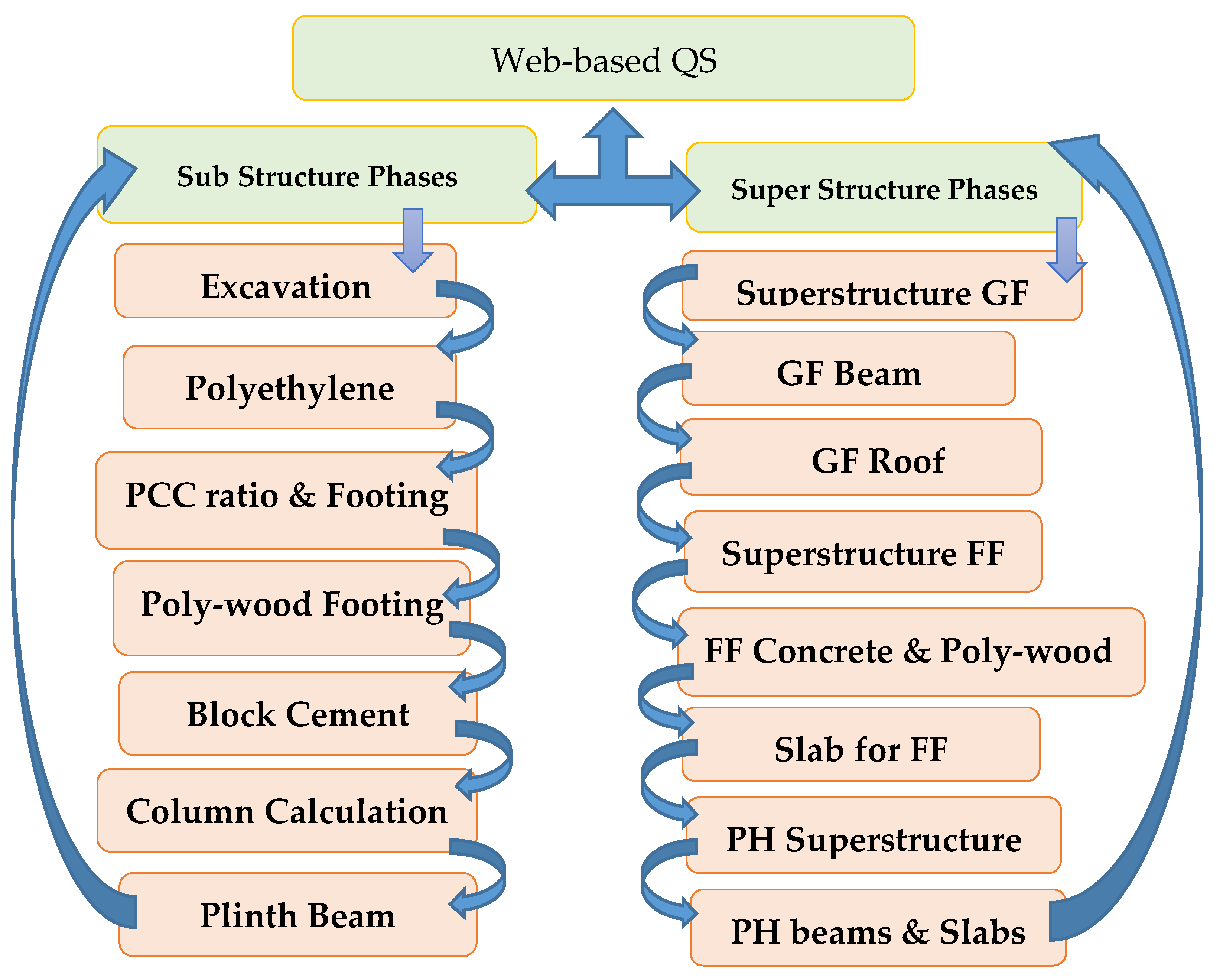




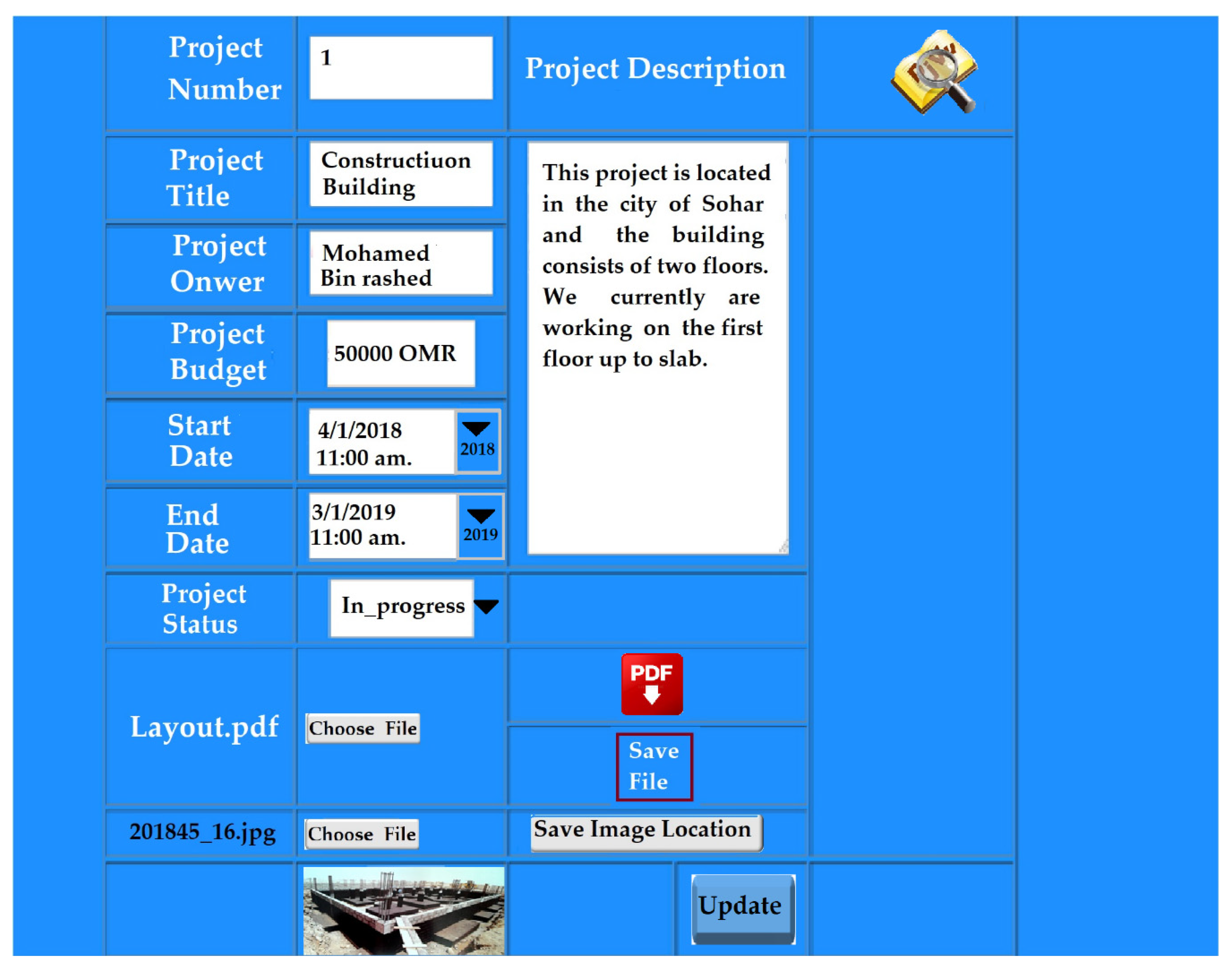
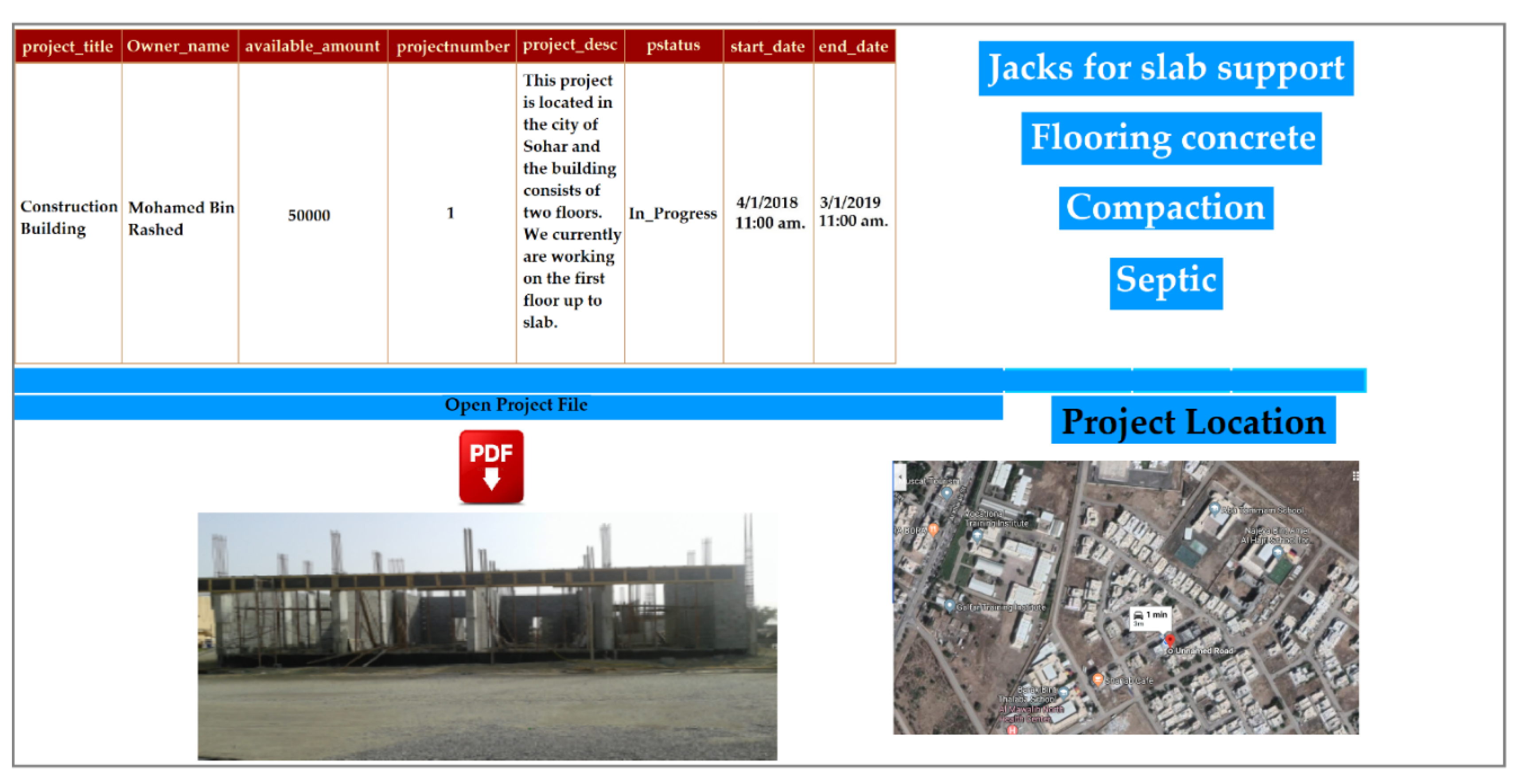
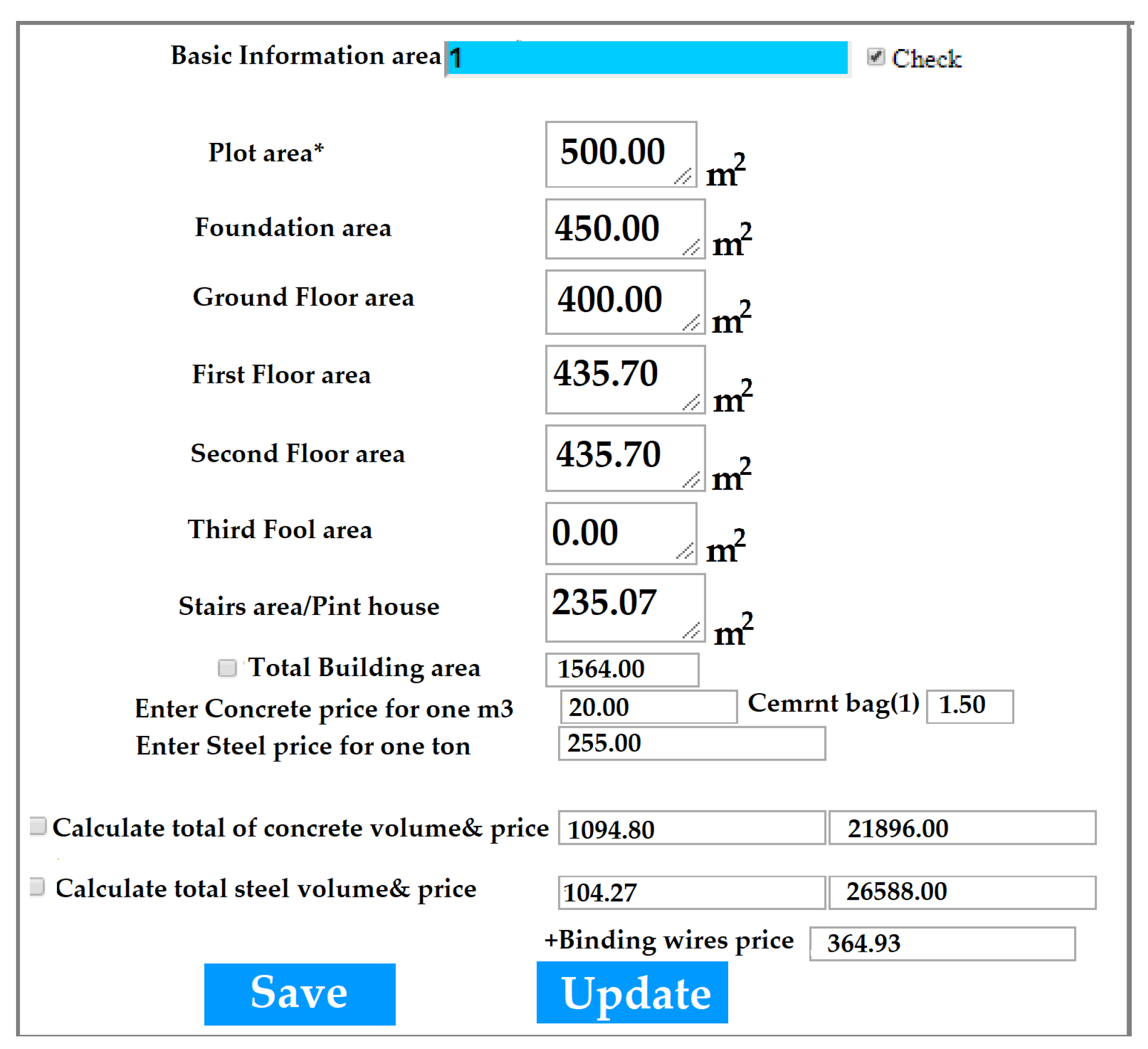

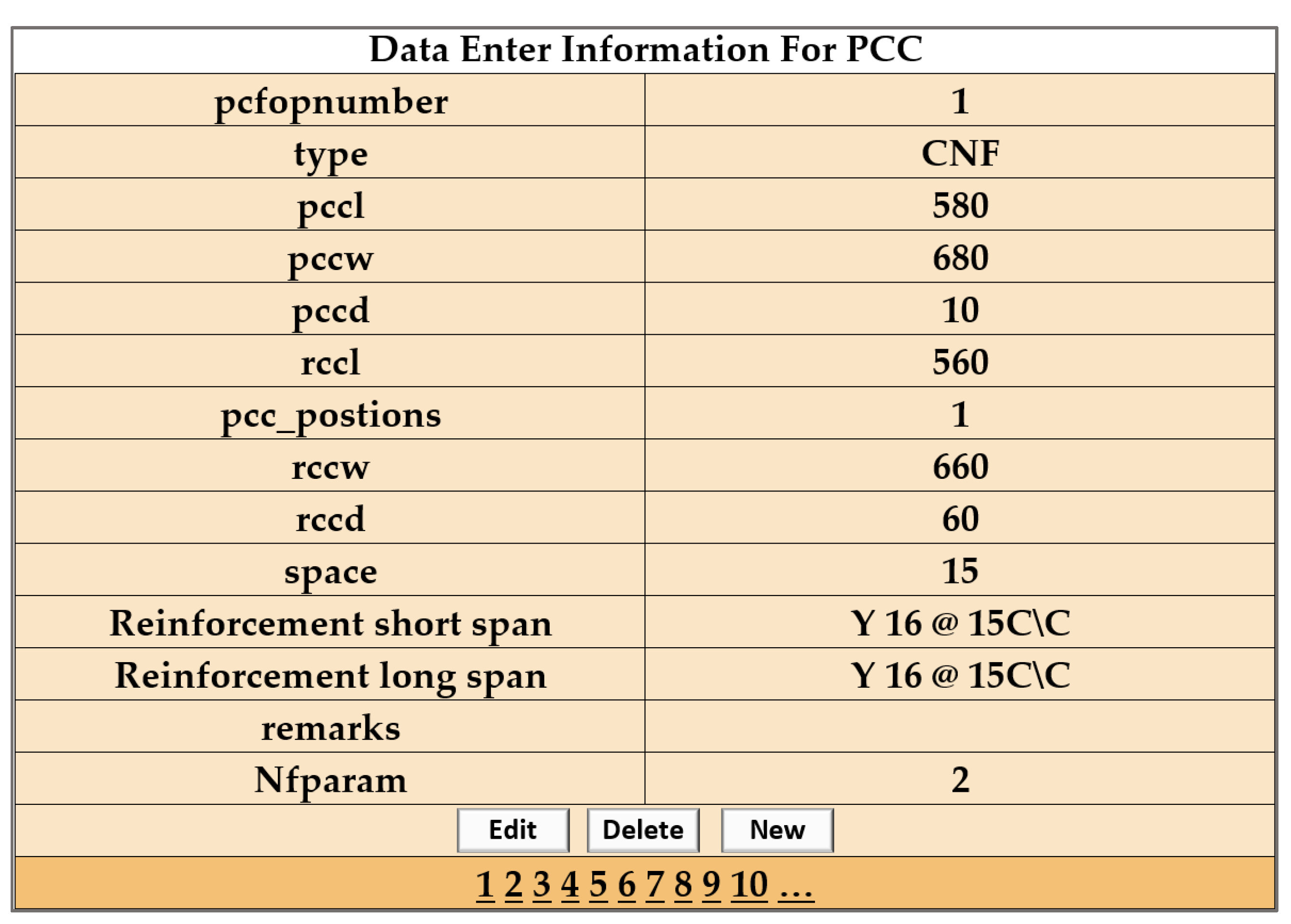
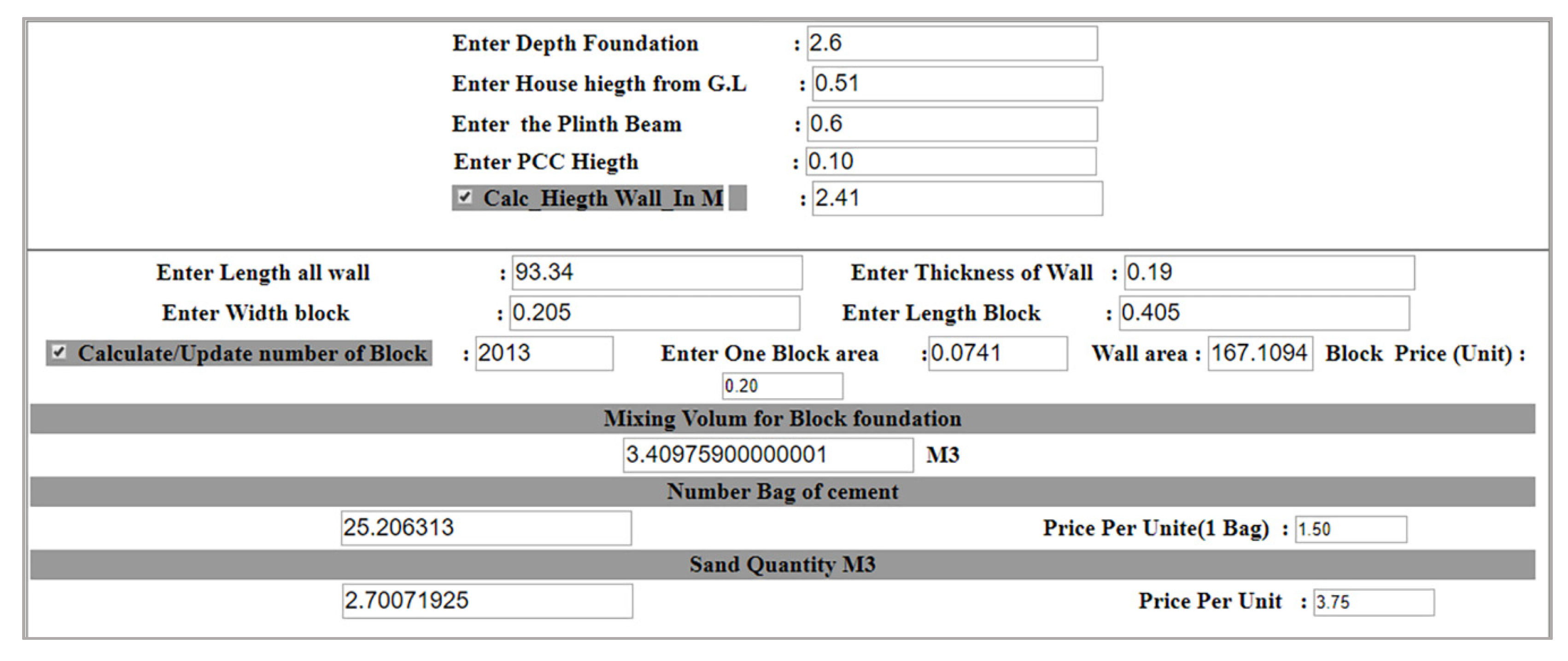



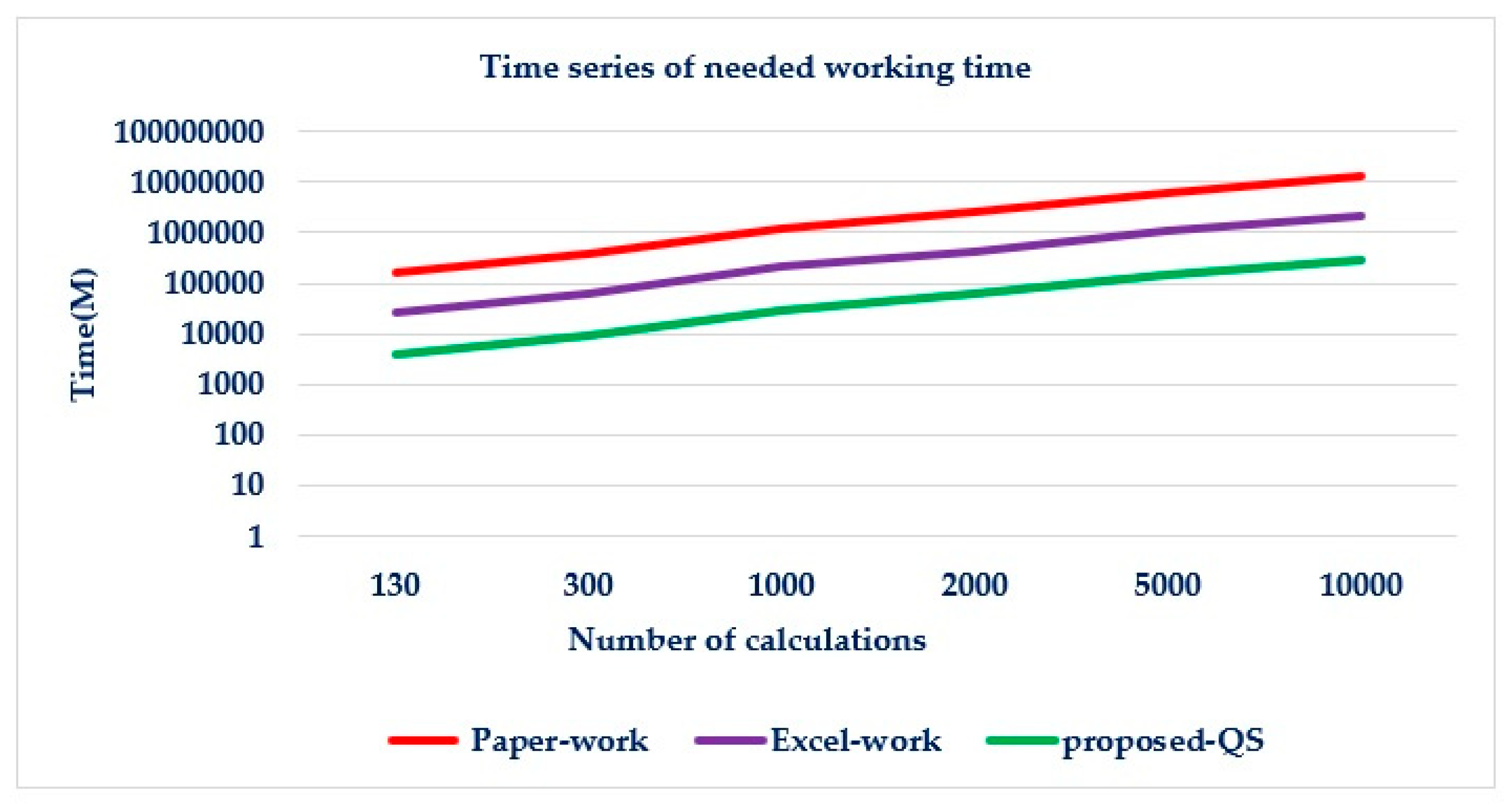
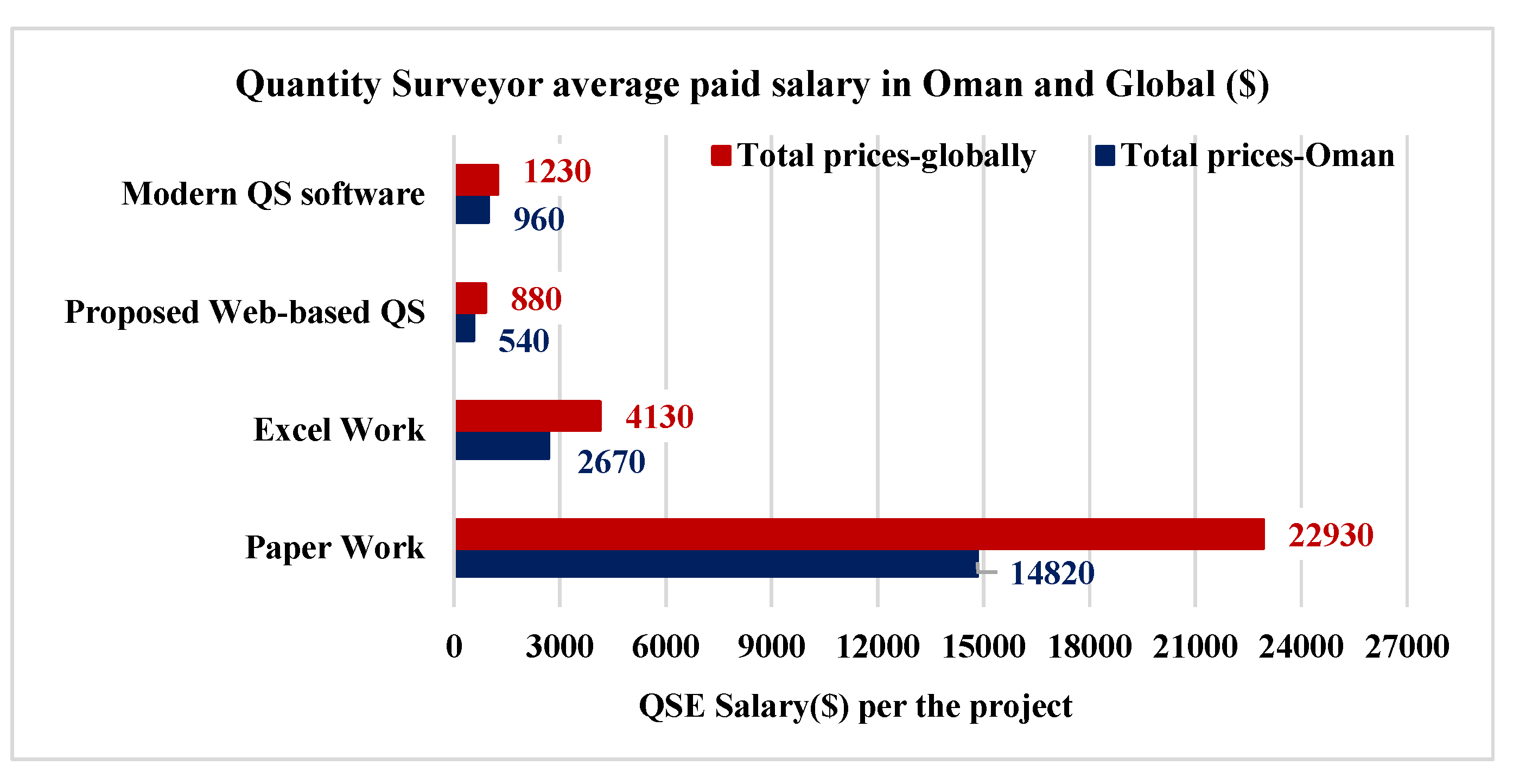
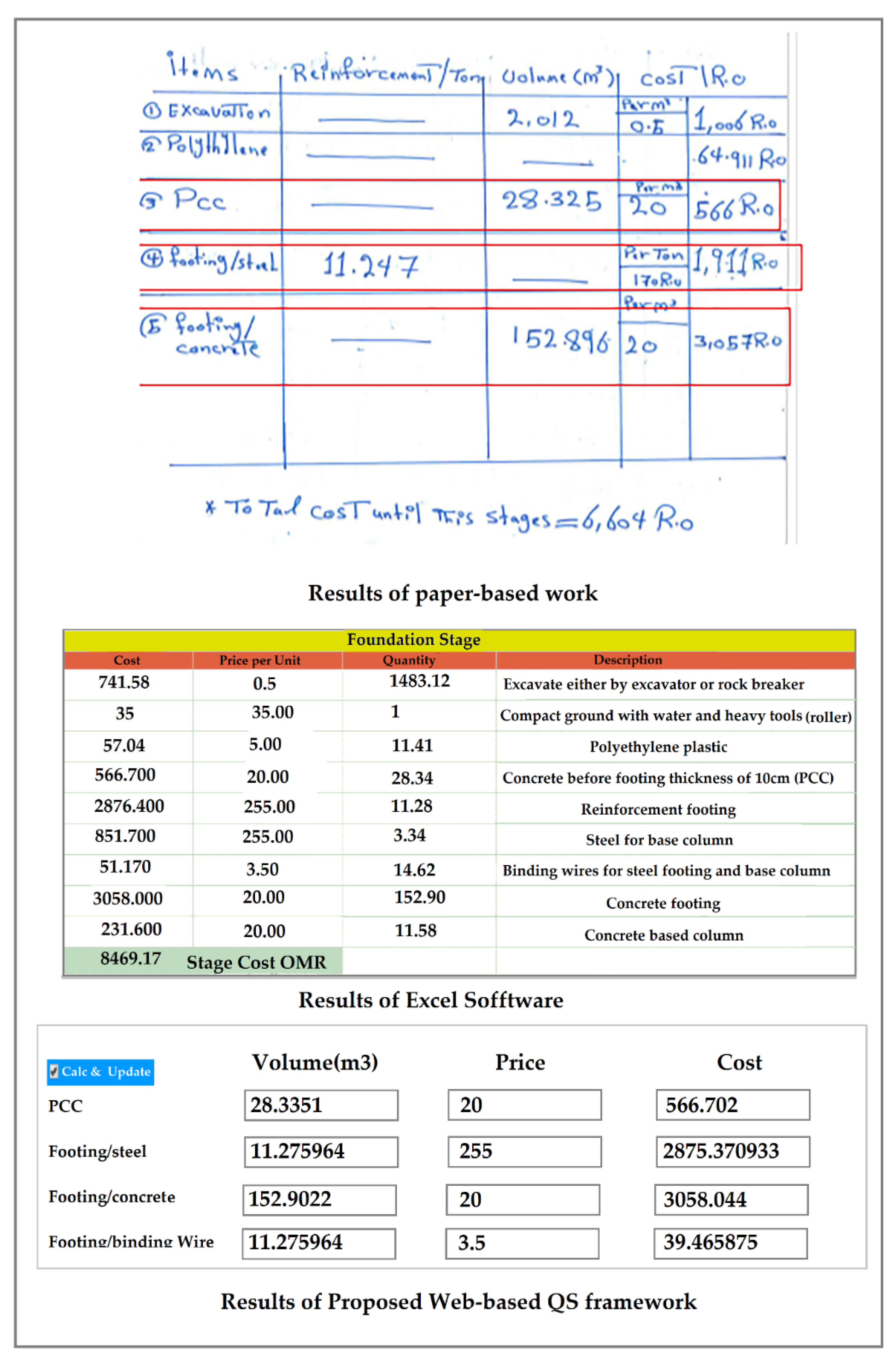
| Support Arabic Language | Digital Modelling | Extract to other Format | Report | Chart | License and Price | Business Size | Platform | |
|---|---|---|---|---|---|---|---|---|
| Autodesk Revit | No | 3D model | Excel sheet via API. | Yes | No | Free trial/ commercial | Large | Windows/Mac |
| Autodesk civil 3D | Yes | 3D model | MX data exported to a GENIO file | Yes | No | Free trial/ commercial | Large | Windows/Mac |
| AutoCAD | Yes | 2D (CAD) model | Bitmap (*.bmp), Block (*.dwg), Encapsulated PS | Yes | No | Free/commercial | Small/ Medium/Large | Windows/Mac |
| AutoCAD land development desktop | Yes | 2D and 3D | DXF Format, Ortho image (*.tif and*.txt) | No | No | Free/commercial | Medium/ Large | Windows |
| EstimatorXpress | Yes | 2D and 3D | Excel (.xls) | Yes | No | Free trail/commercial | Large | Windows/Mac |
| Easybuilder | No | 2D | Excel (.xls), SQL Query, *.gif | Yes | Yes | Free trail/commercial | Large | Windows |
| Planswift pro | Yes | 2D and 3D | Excel (.xls) | Yes | Yes | Free trail/commercial | Small/ Medium/Large | Cloud/Linux Windows/Mac/IOS |
| Costx | Cubicost | Vico Office | Proposed Web-Based | |
|---|---|---|---|---|
| Audience | Subcontractor companies, quantity surveyors, construction companies | Contractors, Home builder, QS consultant, Construction Companies | Construction Companies, Estimators, quantity surveyors | Construction Companies, Estimators, quantity surveyors |
| Company Size | Large and small | Large and small | Large and small | Medium and small |
| Open source Cost calculation | No | No | No | Yes |
| Cost Estimation Method | 3D Take-off | Bill of quantity take-off and cost estimation standards | Take-off | Cost Estimation standards |
| Number of work model at time. | Single model, and needs Cost XL | Cloud-based model SaaS | Single model | Single model, Multi-user |
| Model visualization | 2D, 3D | 2D, 3D | 2D, 3D, 4D | 2D |
| Non-Functional Requirements | |
|---|---|
| ● The system should improve the QS Service. ● The system should be available to all users from any location at any Date/Time. ● The system should provide better performance. ● The System should support new products and services. ● The system should provide stronger control. ● The system should reduce the human error, time, effort, and cost. | |
| Functional Requirements | |
|---|---|
| Concrete Calculation: | ● Store the General information of the project. ● Calculate concrete needed for the PCC. ● Calculate concrete needed for the footing. ● Calculate concrete needed for the column. ● Calculate concrete needed for plinth beam. ● Calculate concrete needed for Beam and Slab of the ground Floor. ● Calculate concrete needed for Beam and Slab of the First Floor. ● Calculate concrete needed for Beam and Slab of the second Floor. ● Calculate concrete needed for Beam and Slab of the Penthouse Floor. ● Calculate Total concrete needed for the whole project. |
| Cement Calculation: | ● Cement needed for blocks work. ● Cement needed for Columns (with the assumption that the columns will be done using site-mixed concrete). ● Cement needed for plaster work of all the walls in the project. ● Cement needed for tiles work (walls and floor). ● Total number of bags of cement needed for the whole project. |
| Blocks Calculation: | ● Calculate Hollow blocks needed for all the walls (40 × 20 cm). ● Calculated Full/Solid blocks needed for foundation walls (40 × 20 cm). |
| Steel Calculation: | ● Steel needed for the foundation, including the (footing + base_column + plinth_beam). ● Steel needed for ground floor (columns + beam + slab). ● Steel needed for first floor (columns + beam + slab). ● Steel needed for Penthouse floor (columns + beam + slab). ● Total Steel needed for the whole project. |
| Category 1 Traditional QS Services | Category 2 QS Professional Tasks | Category 3 Public Sector Services | Category 4 Tender Service | Category 5 Modeling/ Visualization |
|---|---|---|---|---|
| ● Cost estimating ● Cost planning ● Cost studies ● Measurement ● Valuation of construction work ● QS Preparation of final detailed BoQ | ● Provide procurement and contractual advice for the QS ● Monitoring Cost of QS (during project planning) | ● Provide project management service for government ● Time and budget ● Giving expert advice on contractual claims ● Measuring the cost of replacement of buildings damaged by hazard. | ● Recognize cost-risks in tender revenues ● Formulate tender reports ● Analyze total cost of the project | ● Using BIM to automate the Cost estimating ● Financial advisor ● Construction advisor ● generating square meter estimates ● generating cost estimates ● Using BIM Visualization: 3D, 4D, 5D |
| Paper Work | Excel Work | Proposed Web-Based QS | Modern QS Software | |
|---|---|---|---|---|
| Salary (day)-Global | 200$ | 200$ | 200$ | 200$ |
| Salary (day)-Oman | 130$ | 130$ | 130$ | 130$ |
| Training fee | 0$ | 100$ | 100$ | 500$ |
| Annual rent fee | 0$ | 100$ | 50$ | 200$ |
| Time needed (day) | 114 | 19 | 3 | 2 |
| Total prices-Oman | 14820$ | 2670$ | 540$ | 960$ |
| Total prices-globally | 22930$ | 4130$ | 880$ | 1230$ |
| Method/ Factors | Paper Work | Excel Work | Proposed Web-Based QS | Modern QS Software |
|---|---|---|---|---|
| Process Time | Long time | Average | Short time | Short time |
| Use Database | No | No | Yes | Yes |
| Secure | No | Little | Yes | Yes |
| Automation of activities | No | Simi | Full automated | Full automated |
| Damage of data | Yes | Yes | No | No |
| Platform | Paper-based | Computer-based | Web-based | Web-based/Cloud-based/Mobile |
| Updating data | No | No | Yes | Yes |
| Reliability and validity | No | Low (human) | Yes | Yes |
| User Interface | N/A | difficult | Friendly | Friendly |
| Error in calculations | High (human) | Low (human) | Machine computation error | Machine computation error |
| Reports/archive | N/A | N/A | Yes | Yes |
| Price | High (expert human) | Low (one user) | Low (many users) | High (many users) |
| Staff training | No (expert human) | Low (expert human) | Low (expert human) | High (expert human) |
© 2020 by the authors. Licensee MDPI, Basel, Switzerland. This article is an open access article distributed under the terms and conditions of the Creative Commons Attribution (CC BY) license (http://creativecommons.org/licenses/by/4.0/).
Share and Cite
Yousif, J.H.; N. Abdul Majeed, S.; J. I. Al Azzawi, F. Web-Based Architecture for Automating Quantity Surveying Construction Cost Calculation. Infrastructures 2020, 5, 45. https://doi.org/10.3390/infrastructures5060045
Yousif JH, N. Abdul Majeed S, J. I. Al Azzawi F. Web-Based Architecture for Automating Quantity Surveying Construction Cost Calculation. Infrastructures. 2020; 5(6):45. https://doi.org/10.3390/infrastructures5060045
Chicago/Turabian StyleYousif, Jabar H., Saif N. Abdul Majeed, and Fouad J. I. Al Azzawi. 2020. "Web-Based Architecture for Automating Quantity Surveying Construction Cost Calculation" Infrastructures 5, no. 6: 45. https://doi.org/10.3390/infrastructures5060045
APA StyleYousif, J. H., N. Abdul Majeed, S., & J. I. Al Azzawi, F. (2020). Web-Based Architecture for Automating Quantity Surveying Construction Cost Calculation. Infrastructures, 5(6), 45. https://doi.org/10.3390/infrastructures5060045





